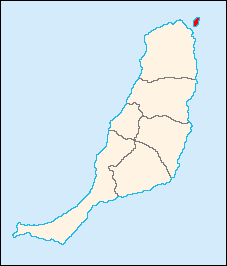Lobos Island facts for kids

Map of Fuerteventura showing Lobos
|
|
| Lua error in Module:Location_map at line 420: attempt to index field 'wikibase' (a nil value). | |
| Geography | |
|---|---|
| Archipelago | Canary Islands |
| Area | 4.68 km2 (1.81 sq mi) |
| Highest elevation | 127 m (417 ft) |
| Administration | |
| Autonomous Community | Canary Islands |
| Province | Las Palmas |
| Municipality | La Oliva |
| Demographics | |
| Population | 4 (2018) |
Lobos (which means Wolves in Spanish) is a tiny island that belongs to Spain. It's part of the Canary Islands and is located just 2 kilometers (about 1.2 miles) north of Fuerteventura.
This small island is about 4.68 square kilometers (1.8 square miles) in size. Since 1982, Lobos has been a special nature reserve called Parque Natural del Islote de Lobos. This means its plants, animals, and landscape are protected.
You can visit Lobos Island by taking a short ferry ride from Corralejo, a town in northern Fuerteventura. The island has places for day visitors and small homes for local fishermen. It's a great spot for hiking and snorkeling. At the very top of the island, you'll find the Punta Martiño Lighthouse. The lighthouse keeper and his family were the last people to live on Lobos permanently. They moved away when the lighthouse became automatic in the 1960s.
In 1405, Lobos Island was used as a supply base by Jean de Béthencourt when he was conquering Fuerteventura.
Contents
Why is it called Lobos Island?
Lobos Island got its name because of the many sea wolves that used to live there. These animals are also known as monk seals.
When Spanish explorers first found the Canary Islands in the 1400s, monk seals were the only creatures living on Lobos. However, when people arrived, they hunted these seals a lot. Sailors and fishermen used them for food, fat, and their skins. Because of all this hunting, the monk seals eventually disappeared from the island. Now, you might only see one occasionally.
History of Lobos Island
Scientists have found old things on Lobos Island that show Ancient Rome had a settlement there. This settlement was probably used only at certain times of the year. It was likely for getting a special purple dye.
As mentioned, in 1405, Lobos Island was a key spot for Jean de Béthencourt during his conquest of Fuerteventura. For a long time, until 1968, the only people living on the island were the lighthouse keeper and his family. Their job was to operate the Faro de Lobos lighthouse. This lighthouse is a famous landmark at the northern tip of the island. The lighthouse keeper's name was Antonito, and a school in Corralejo was even named after him!
Lobos Island was one of the first natural areas in the Canary Islands to become a natural park in 1982. Later, it was also made a special protection area for birds. Many different kinds of birds that travel long distances live on the island.
Geography of Lobos Island
Like all the other Canary Islands, Lobos Island was formed by volcanoes. Scientists believe it is between 6,000 and 8,000 years old.
The highest point on the island is a volcanic caldera called Montaña La Caldera. It stands 127 meters (about 417 feet) above sea level. The island also has a small lake. However, because it doesn't rain much, the landscape is very dry and desert-like.
Animals and Plants of Lobos Island
Even though Lobos Island is a dry, volcanic place, it has many different natural habitats. Because of its amazing variety of life, it's a protected area called the Parque Natural del Islote de Lobos.
There are over 130 types of plants on the island. One special plant is the siempreviva (Limonium ovalifolium), which only grows on Lobos. Another interesting plant is the Sea Uvilla (Tetraena fontanesii), known for its unique shape and color.
Birds are also a very important part of the island. Many different kinds of seabirds nest on the cliffs and rocks. Some of the birds that breed here include Cory's and little shearwaters, European and band-rumped storm petrels, and kentish plovers. Lobos Island has been named a special protection area (SPA) for birds. It's also recognized as an Important Bird Area (IBA) by BirdLife International.
Besides birds, you can see many different kinds of fish in the waters around Lobos. Some common fish include barracuda, hammerhead sharks, and bream.
Visiting Lobos Island
Lobos Island is a popular place for tourists who are visiting Fuerteventura. People come to enjoy the plants, animals, and unique geology of the island.
Regular boat services take passengers from Corralejo harbor during the day. To protect the island's natural beauty, visitors can only go to certain areas. There are special walking trails with signs to guide you and keep you away from sensitive conservation areas. These paths lead visitors from the boat dock to different parts of the island, including the lighthouse at Punto Martino and the top of the volcanic caldera. There's also a small, calm sea lagoon called Playa de la Concha, which has a sandy beach perfect for swimming.
Before 2007, visitors could ask the Fuerteventura government for permission to camp on the island for up to three nights in a specific spot called "El carpintero". However, since 2007, camping is no longer allowed on Lobos Island.
Images for kids
See also
 In Spanish: Islote de Lobos (Canarias) para niños
In Spanish: Islote de Lobos (Canarias) para niños











